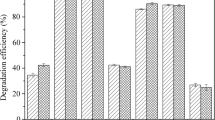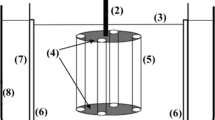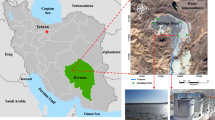Abstract
A sample of polyvinyl chloride (PVC) powder was milled with CaO powder in a planetary mill for various mill operational parameters. The milled product consisted of dechlorinated hydrocarbon and water-soluble CaOHCl. The dechlorination rate of PVC was determined by the concentration of Cl− ions measured in solution after dispersing the milled product in water. To evaluate the power consumption during PVC dechlorination, the mill power consumption was measured during each experimental run. In addition, media motion during planetary milling was simulated using the discrete element method (DEM), enabling calculation of the mill power consumption. The power consumption calculated by the DEM simulation compared well with the power consumption measured experimentally. The dechlorination rate correlated well with the specific mill power consumption, regardless of the sample weight. The dechlorination rate of PVC when milled with oyster shells (CaCO3) was observed to be faster than that of the PVC/CaO system, and oyster shells could be used as a reactant for the treatment of PVC wastes. This work should be useful for the design of a reactor for the dechlorination of PVC.
Similar content being viewed by others
References
Fukumoto T (1977) Disposal technology of waste materials. Kyoritsu, Tokyo
Furubayashi K (1997) Disposal technologies by means of refuse-derived fuel (RDF). Kagaku Kagaku 61:502–505
Murata K (1997) Technologies for liquefying waste plastics. Kagaku Kagaku 61:510–512
Borgianni C, De Filippis P, Pochetti F, Paolucci M (2002) Gasification process of wastes containing PVC. Fuel 81:1827–1833
Jaksland C, Rasmussen E, Rohde T (2000) A new technology for treatment of PVC waste. Waste Manag 20:463–467
Qiao WM, Song Y, Yoon SH, Korai Y, Mochida I, Yoshiga S, Fukuda H, Yamazaki A (2006) Carbonization of waste PVC to develop porous carbon material without further activation. Waste Manag 26:592–598
Slapak MJP, van Kasteren JMN, Drinkenburg AAH (2000) Design of a process for steam gasification of PVC waste. Resour Conserv Recy 30:81–93
Takeshita Y, Kato K, Takahashi K, Sato Y, Nishi S (2004) Basic study on treatment of waste polyvinyl chloride plastics by hydrothermal decomposition in subcritical and supercritical regions. J Supercritic Fluid 31:185–193
Zhang Q, Saito F, Shimme K, Masuda S (1999) Dechlorination of PVC by a mechanochemical treatment. J Soc Powder Technol Jpn 36:468–473
Saeki V, Kano J, Saito F, Shimme K, Masuda S, Inoue T (2001) Effect of additives on dechlorination of PVC by mechanochemical treatment. J Mater Cycles Waste Manag 3:20–23
Inoue T, Miyazaki M, Kamitani M, Kano J, Saito F (2004) Mechanochemical dechlorination of polyvinyl chloride by cogrinding with various metal oxides. Adv Powder Technol 15:215–225
Inoue T, Miyazaki M, Kamitani M, Kano J, Saito F (2005) Dechlorination of PVC by its grinding with KOH and NaOH. Adv Powder Technol 16:27–34
Tongamp W, Kano J, Zhang Q, Saito F (2006) Mechanochemical decomposition of PVC by using La2O3 as additive. J Hazard Mater B137:1226–230
Tongamp W, Kano J, Zhang Q, Saito F (2008) Simultaneous treatment of PVC and oyster-shell wastes by mechanochemical means. Waste Manag 28:484–488
Mio H, Saeki S, Kano J, Saito F (2002) Estimation of mechanochemical dechlorination rate of poly(vinylchloride). Environ Sci Technol 36:1344–1348
Kano J, Chujo N, Saito F (1997) A method for simulating the three-dimensional motion of balls under the presence of a powder sample in a tumbling ball mill. Adv Powder Technol 8:39–51
Kano J, Saito F (1998) Correlation of ball impact energy with yield of soluble vanadium compound produced in EP dust by dry mechanochemical treatment. J Chem Eng Jpn 31:1014–1015
Kano J, Mio H, Saito F (1999) Correlation of size reduction rate of inorganic materials with impact energy of balls in planetary ball mill. J Chem Eng Jpn 32:445–448
Suzuta Y, Kano J, Saito F (2007) Prediction of power consumption during planetary ball milling by DEM simulation and its correlation with grinding rate constant. J Soc Powder Technol Jpn 44: 180–185
Mishra BK (2003) A review of computer simulation of tumbling mills by the discrete element method. Part II: practical applications. Int J Miner Process 71:95–112
Powell MS, McBride AT (2006) What is required from DEM simulations to model breakage in mills? Miner Eng 19:1013–1021
Datta A, Mishra BK, Rajamani RK (1999) Analysis of power draw in ball mills by the discrete element method. Can Metall Quart 38:133–140
Abd EL-Rahman MK, Mishra BK, Rajamani RK (2001) Industrial tumbling mill power prediction using the discrete element method. Miner Eng 14:1321–1328
Monama GM, Moys MH (2002) DEM modeling of the dynamics of mill startup. Miner Eng 15:487–492
Gantt JA, Gatzke EP (2005) High-shear granulation modeling using a discrete element simulation approach. Powder Technol 156:195–212
Author information
Authors and Affiliations
Corresponding author
Additional information
Chemical Feedstock Recycling & Other Innovative Recycling Techniques 6
Rights and permissions
About this article
Cite this article
Tongamp, W., Kano, J., Suzuta, Y. et al. Relation between mechanochemical dechlorination rate of polyvinyl chloride and mill power consumption. J Mater Cycles Waste Manag 11, 32–37 (2009). https://doi.org/10.1007/s10163-008-0216-2
Received:
Accepted:
Published:
Issue Date:
DOI: https://doi.org/10.1007/s10163-008-0216-2




